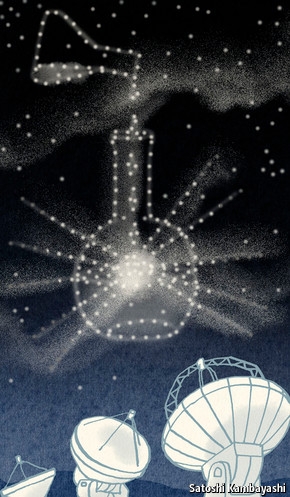(单词翻译:单击)

MOST people think of the empty space between the stars as being, well, empty. But it is not. It is actually filled with gas. Admittedly, at an average density of 100-1,000 molecules per cubic centimetre (compared with 100 billion billion in air at sea level), it is a pretty thin gas. But space is big, so altogether there is quite a lot of it.
大多数人们认为星星之间就是空无一物,但事实并非如此。实际上有气体弥散其中。诚然,分子平均密度10^2-10^3/cm^3的气体非常稀薄(海平面处是10^26/cm^3)。不过由于空间很广阔,气体分子总体数量是可观的。
Most of it, about 92%, is hydrogen. A further 8% is helium, which is chemically inert. But a tiny fraction—less than one-tenth of a percent—consists of molecules with other elements, such as oxygen, carbon and nitrogen, in them. Though these other elements are a mere soupçon of the interstellar soup, they do give it real flavour.
大部分(约92%)的气体是氢,另外8%是惰性气体氦。还有一小部分(不超过千分之一)由氧、碳、氮等其他元素构成的分子。虽然这些元素仅仅是“星际浓汤”轻微的调料,但它们确实增添了汤的味道。
Signs of life
生命的迹象
So far about 180 types of these molecular ingredients have been detected in space from their microwave spectra—the energy produced when molecules rotate around their chemical bonds. There are two reasons for wanting to study them. One is that these molecules are probably the precursors of life. The other is that the rarefied nature of astrochemistry changes the way processes work. It means the individual steps in chemical reactions can be disentangled from one another in a way that is hard—and sometimes impossible—on Earth. And it allows reactions to happen that are unknown on Earth.
到目前为止,人们已经通过微波谱线探测出约180种分子成分。分子绕其化学键旋转时,分子能级会发生改变,从而产生微波谱线。研究微波谱线有两个原因。一是分子可能是生命的预兆。二是天体化学其稀薄的属性会改变化学反应的过程。人们可以用这种方式把化学反应中独立的一步从彼此步骤间分离出来,有时这在地球上很难实现。并且还有可能发生人类未知的化学反应。
Now the astrochemists have a new tool: the Atacama Large Millimetre/submillimetre Array (ALMA) in northern Chile. It was officially opened on March 13th but has already been making discoveries, including the most intense bursts of star birth in the early universe. ALMA consists of 66 dishes and is the world’s most powerful radio telescope. At a cost of $1.3 billion it should provide a hundredfold increase in sensitivity and resolution over the best older instruments.
现在天体化学家有了新工具:阿塔卡马大型毫米/亚毫米波天线阵(ALMA,位于智利北部)。3月13日ALMA正式运作,到现在已经有了发现,例如宇宙早期恒星诞生最激烈的爆发。ALMA有66台天线,是世界上最强劲的射电望远镜。花费13亿美元想必会使灵敏度分辨率比过去最好的仪器还要好百倍。
Those older telescopes had to focus on nebulae, where the interstellar gas is most concentrated (a familiar one, visible through binoculars, is the gas cloud around the stars that make up Orion’s sword). And older telescopes can detect only strong, simple signals of the sort emitted by small molecules like carbon monoxide and hydrogen cyanide, which have two and three atoms respectively. Spotting more complex substances was almost impossible because their rotational energy is scattered by their numerous bonds across a wide range of frequencies.
以往的望远镜必须关注星云,那里是星际气体最集中之处。一个可用双筒望远镜看到的典例是气体环绕恒星所形成的猎户座的”剑”。并且老望远镜只能探测到一氧化碳(双原子)、氢氰化物(三原子)等小分子释放出的强的,简单的信号。而鉴别更复杂的物质几乎不可能,大量化学键占有很宽的频率范围,以至于旋转能被散射掉。
ALMA, by contrast, can detect such things routinely. It has already identified glycolaldehyde and acetone, molecules that have eight and ten atoms respectively. In particular, ALMA’s masters, a consortium of research agencies from Canada, Chile, Europe, Japan, Taiwan and the United States, hope to find simple sugars and organic acids—molecules most researchers in the field believe were needed to get life going on Earth.
相反ALMA可以轻易探测到这些信号:它已经鉴定出了乙醇醛(8原子分子)和丙酮(10原子分子)。特别的,由加拿大、智利、欧洲、日本、台湾及美国的财团组成的研究机构掌控ALMA,希望以此寻觅简单的糖类和有机酸——该领域大多数研究人员认为它们是地球上生命的必需之物。
The ability to study chemical reactions stage by stage will be equally important. High-school chemistry lessons, with their neat equations transforming, say, 2H₂ + O₂ into 2H₂O, miss out a plethora of intermediate steps such as (in this case) the formation of hydroxyl, OH. In a lab, these intermediates are often too short-lived to be detectable. But in space an intermediate may hang around a long time before it encounters its partner in the next stage of a reaction. ALMA can see the microwave traces of such intermediates, and thus gain a better understanding of them.
能够研究化学反应中的每一步同样很重要。高中化学课上简单的反应方程式省略了大量的中间步骤。例如2H₂ + O₂ = 2H₂O就没有体现形成羟基(OH)的过程。实验室里,这些中间过程非常短暂,人们难以探测。不过在太空中,一个中间过程会持续很长时间,直到碰到下一步反应的搭档。ALMA可以看到这些中间过程的微波轨迹,因此研究者可以更好的了解这些过程。
There are also completely new reactions to discover. Anthony Remijan, of America’s National Radio Astronomy Observatory, who is one of the astronomers putting ALMA through its paces, is studying the formation of methyl formate, a compound widely used on Earth in applications from insulation to insecticides. Usually it is synthesised either from methanol and formic acid, or methanol and carbon monoxide. But there is, in theory, a third route that uses formic acid and an unstable substance made from methanol and hydrogen. This has not been seen in an Earthly laboratory, but Dr Remijan thinks it is an important pathway in space, and ALMA should soon tell him if he is right.
还有全新的反应有待人们发现。美国国家射电天文台的Anthony Remijan是将ALMA引入这个方向的天文学家中的一员。他正在研究甲酸甲酯的形成过程。从绝缘体到杀虫剂,可以说地球上到处都是甲酸甲酯。通常它由甲醇和甲酸,或甲醇和一氧化碳合成。但是在理论上,还可以使用甲酸和一种不稳定的物质来制造甲酸甲酯。(不稳定的物质则由甲醇和氢来形成。)这还没有在地球上的实验室中发现,但Remijan博士认为在太空中这是一个重要的过程。ALMA应该很快就会告诉他他是否正确。
Probably, that particular discovery will have no practical consequences. The known syntheses are effective, and methyl formate is already cheap. But it will prove a principle about using the cosmos as a chemistry laboratory,and the hope is that similar findings about other molecules that are harder to make may allow chemical engineers at home to reformulate their processes.If that happens, the test tube in the sky really will have proved its worth.
也许,上述特别的发现不会产生实用效果。甲酸甲酯熟知的合成方法很有效,而且它很便宜。但是,这证明了一个理念:用宇宙充当化学实验室。希望有关其他较难制造的分子的类似发现能够让化学工程师在家里重新制定它们的合成过程。如果可以,天空中的试管确实有其价值。


